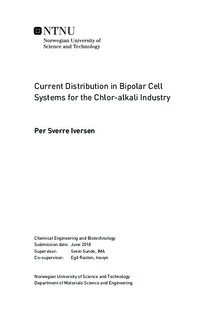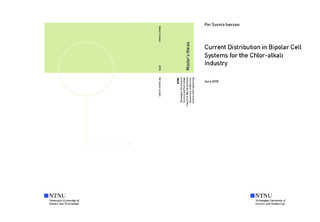| dc.description.abstract | The chlor-alkali industry is one of Europe s largest chemical industries and produces chlorine gas, hydrogen gas and sodium hydroxide. One of the main production methods is to use membrane cells that are assembled into a bipolar cell system. Operating such a cell system uses a lot of energy, in addition to consuming rare metals such as ruthenium and iridium by degradation of the electrode coatings. During the replacements of the electrodes, most of them are sent back to recoating, without being fully worn out. By increasing the current efficiency and to predict the lifetime of the coatings in-situ, the operating cost of the chlor-alkali process could be reduced.
The aim of this master thesis was to be able to dynamically simulate the current distributions throughout the bipolar cell system, including shunt currents. The simulations would be used to look at what degree of impact the different inlet tube lengths had on the current distribution during steady state operation and during the discharge stage. Also, to look at what impact the different capacitance values have for the electrodes had on the discharge rate, in order to see if it was possible to predict in-situ the state of the electrode coatings, based on discharge data.
A theoretical model for the potentials in the electrolytes throughout the bipolar cell system was constructed. The model was then used as the basis for programming a code that would be able to dynamically simulate the potentials during steady state operation and during the discharge stage. From the potentials and the resistances in the electrolyte, the current distribution could be found. Electrochemical impedance spectroscopy was done to the anode and cathode samples in order to determine the capacitance of the electrodes.
It was found that the longer the anodic and cathodic inlet tubes were, the more current went
through the cell system itself, during steady state operation. The increased current through the cell system led to a decrease of the current going through the headers, and therefore gave a greater power efficiency. During the discharge stage, it was found that the impact of the inlet tube lengths were significantly smaller, than during steady state operation. It was also found that the capacitance values of the electrodes significantly affected the discharge rate. | en |

